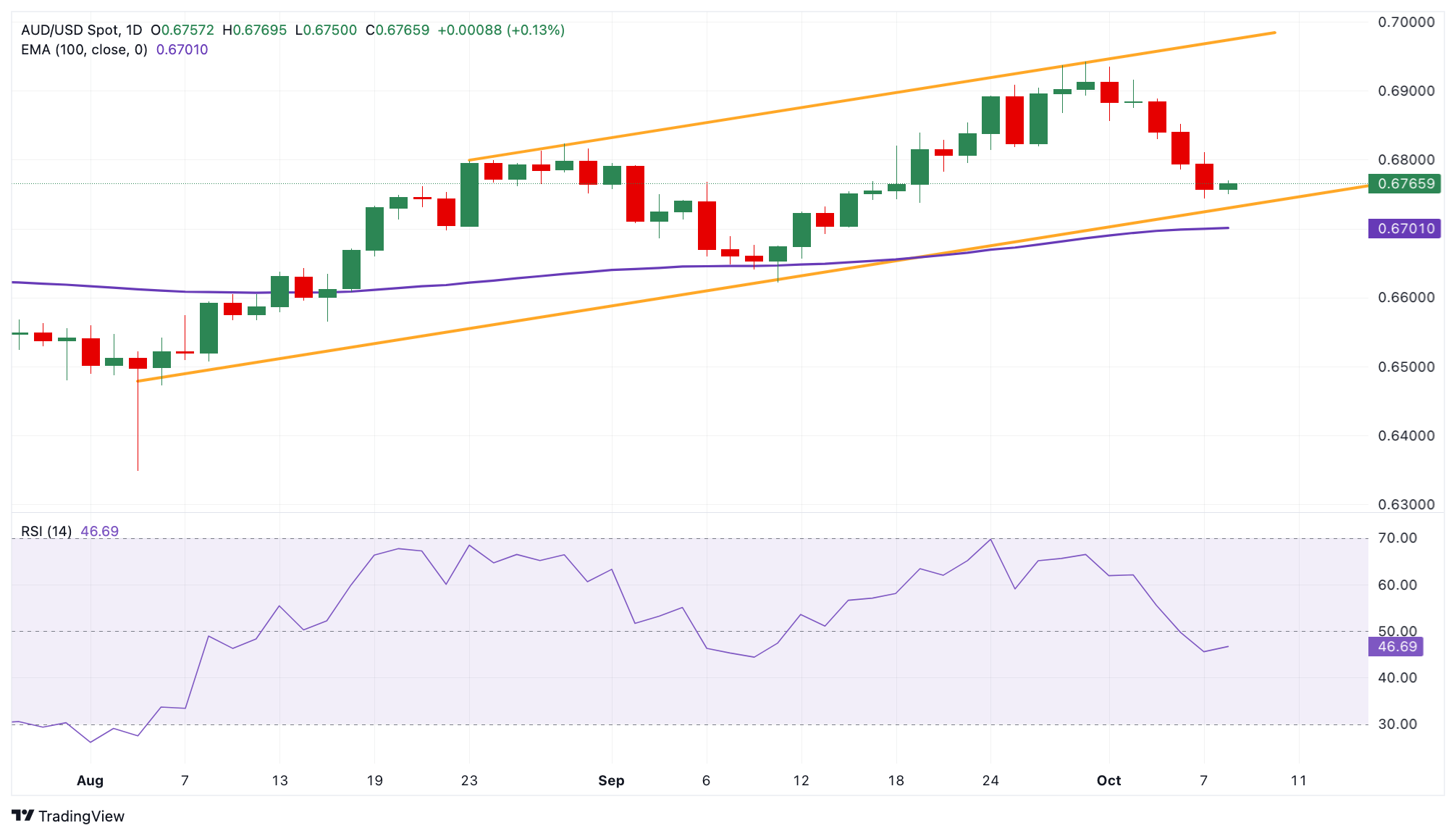- The Australian Dollar regains some ground in the Asian session on Tuesday.
- RBA’s hawkish comments boost AUD, but fear of geopolitical risks could limit its upside.
- Investors will be watching the Fed’s comments later on Tuesday.
The Australian Dollar (AUD) trades higher on Tuesday, breaking a three-day losing streak. The Reserve Bank of Australia’s (RBA) hawkish tone following the September meeting minutes provides some support to the AUD. However, risk-off sentiment amid rising geopolitical tensions in the Middle East could put some selling pressure on riskier assets like the AUD for the time being.
Looking ahead, investors await comments from the Fed later on Tuesday for fresh impetus ahead of the Federal Open Market Committee (FOMC) minutes. The focus will be on the US Consumer Price Index (CPI) for September, which will be published on Thursday.
Daily Market Summary: Australian Dollar Gains Ground After RBA Minutes
- According to minutes of the RBA’s September meeting published on Tuesday, council members discussed scenarios for lowering and raising interest rates in the future.
- “Policy should remain restrictive until board members are confident that inflation is moving sustainably towards the target range,” the RBA minutes noted.
- St. Louis Fed President Alberto Musalem signaled Monday that he supports additional interest rate cuts as the economy moves forward. Musalem added that performance will determine the path of monetary policy, according to Reuters.
- Minneapolis Fed President Neel Kashkari said on Monday he supported the Fed’s decision to cut rates by 50 bps, adding that the balance of risks shifted from “high inflation to perhaps higher unemployment.”
- According to the CME FedWatch tool, markets have priced in a nearly 85% probability of 25 bps Fed rate cuts in November, up from 31.1% last week.
Technical Analysis: Australian Dollar maintains long-term bullish bias
The Australian Dollar pair bounces on the day. According to the daily chart, the AUD/USD pair remains trapped within the lower boundary of the uptrend channel. The pair maintains the bullish bias as it is well supported above the 100-day EMA. However, further consolidation or decline cannot be ruled out as the 14-day Relative Strength Index (RSI) is below the midline near 47.0.
The lower boundary of the trend channel near 0.6735 acts as an initial support level for AUD/USD. A break of the mentioned level could create bearish momentum that drags the pair towards the psychological level of 0.6700. The additional downside filter to watch is 0.6622, the 9/11 low.
To the upside, the first barrier to the upside emerges at 0.6823, the August 29 high. Extended gains could pave the way towards 0.6942, the September 30 high. A decisive break above this level could attract enough buyers to push AUD/USD towards the upper boundary of the trend channel at 0.6980.
The Australian Dollar FAQs
One of the most important factors for the Australian Dollar (AUD) is the level of interest rates set by the Reserve Bank of Australia (RBA). As Australia is a resource-rich country, another key factor is the price of its largest export, iron ore. The health of the Chinese economy, its largest trading partner, is a factor, as is inflation in Australia, its growth rate and the Balance of Trade. Market sentiment, that is, whether investors bet on riskier assets (risk-on) or seek safe havens (risk-off), is also a factor, with the risk-on being positive for the AUD.
The Reserve Bank of Australia (RBA) influences the Australian Dollar (AUD) by setting the level of interest rates that Australian banks can lend to each other. This influences the level of interest rates in the economy as a whole. The RBA’s main objective is to maintain a stable inflation rate of 2%-3% by adjusting interest rates up or down. Relatively high interest rates compared to other major central banks support the AUD, and the opposite for relatively low ones. The RBA can also use quantitative easing and tightening to influence credit conditions, with the former being negative for the AUD and the latter being positive for the AUD.
China is Australia’s largest trading partner, so the health of the Chinese economy greatly influences the value of the Australian Dollar (AUD). When the Chinese economy is doing well, it buys more raw materials, goods and services from Australia, which increases demand for the AUD and drives up its value. The opposite occurs when the Chinese economy does not grow as fast as expected. Therefore, positive or negative surprises in Chinese growth data usually have a direct impact on the Australian Dollar.
Iron ore is Australia’s largest export, with $118 billion a year according to 2021 data, with China being its main destination. The iron ore price, therefore, may be a driver of the Australian dollar. Typically, if the price of iron ore rises, the AUD also rises as aggregate demand for the currency increases. The opposite occurs when the price of iron ore falls. Higher iron ore prices also tend to result in a higher likelihood of a positive trade balance for Australia, which is also positive for the AUD.
The trade balance, which is the difference between what a country earns from its exports and what it pays for its imports, is another factor that can influence the value of the Australian dollar. If Australia produces highly sought-after exports, its currency will gain value solely from the excess demand created by foreign buyers wanting to purchase its exports versus what it spends on purchasing imports. Therefore, a positive net trade balance strengthens the AUD, with the opposite effect if the trade balance is negative.
Source: Fx Street
I am Joshua Winder, a senior-level journalist and editor at World Stock Market. I specialize in covering news related to the stock market and economic trends. With more than 8 years of experience in this field, I have become an expert in financial reporting.








